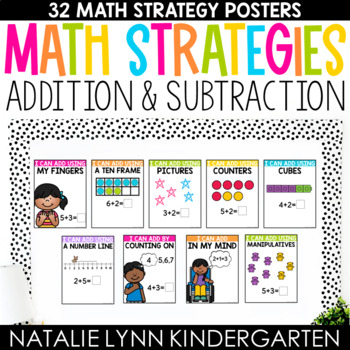Addition and Subtraction Math Strategies Posters
- PDF
What educators are saying
Description
Are you working on addition and subtraction strategies in Kindergarten or 1st grade? These addition and subtraction math strategies posters provide a visual reminder for students. Use each math strategy poster as you introduce it and then display.
These posters are included in my Kindergarten Addition Unit and Kindergarten Subtraction Unit. If you own those units, you will not want to purchase.
This set of math strategy posters includes 18 addition strategies posters and 14 subtraction strategies posters.
MATH STRATEGIES POSTERS INCLUDED:
ADDITION STRATEGIES POSTERS
- fingers
- ten frames
- pictures
- counters
- cubes
- number line
- counting on
- in my mind
- manipulatives
- tally marks
- draw dots
- turn around facts
- doubles
- doubles +1
- base ten
- rekenrek
- hundreds chart
SUBRACTION STRATEGIES POSTERS
- fingers
- ten frame
- pictures
- counters
- cubes
- number line
- counting back
- manipulatives
- crossing out
- rekenrek
- turn around facts
- base ten
- hundreds chart
FREQUENTLY ASKED QUESTIONS
Do I need to use every math strategy poster included? No! You will only want to use the math strategies posters for the addition and subtraction strategies you teach.
What size are these posters? These posters are available both vertically and horizontally. They are 8.5x11 or 11x8.5.
Does this set include any other addition and subtraction activities? No, this set only includes the math strategies posters shown. They would pair well with any addition or subtraction math units!
Can I edit or translate these math strategies posters? No, I am sorry, but these addition and subtraction strategies posters are not editable or being translated at this time.
Are these addition and subtraction strategies posters included in any other resource or bundle? yes! These posters are included in the Kindergarten addition and subtraction units. They will also be included in the 1st grade math curriculum when it is released. ;)





